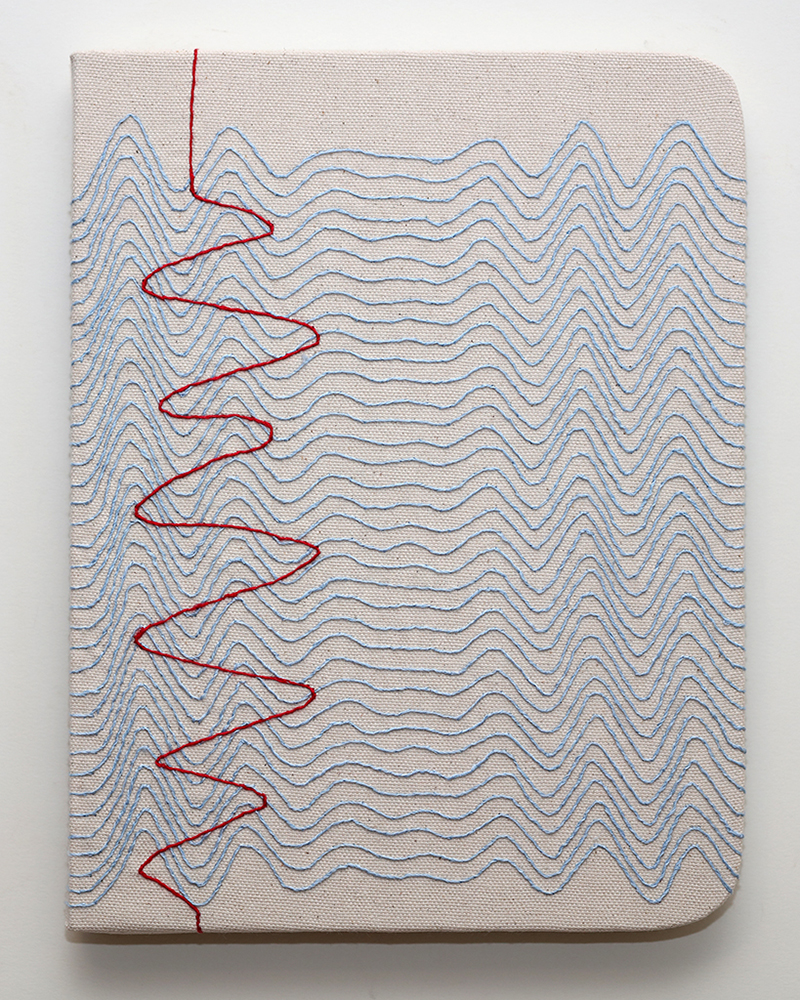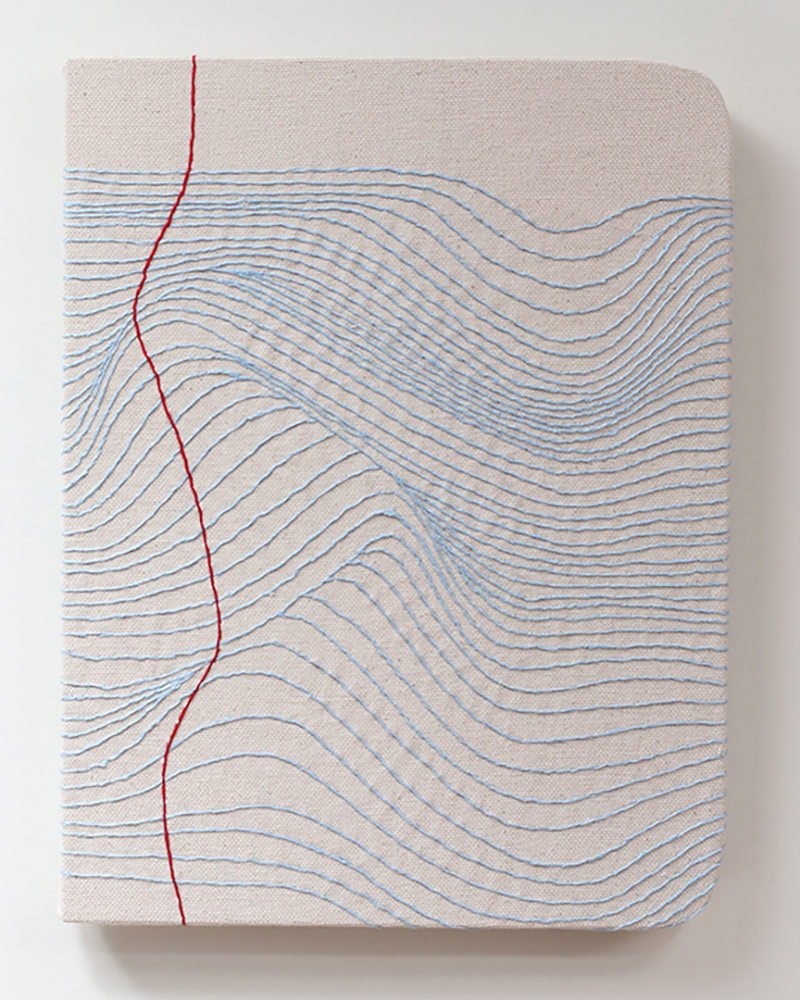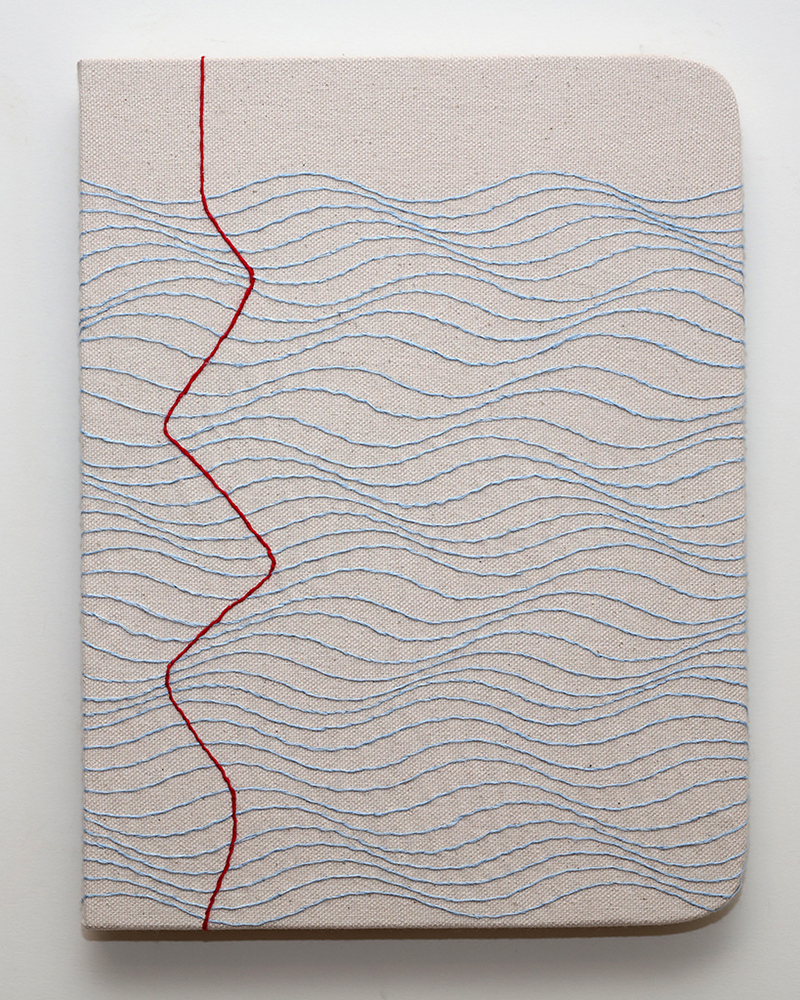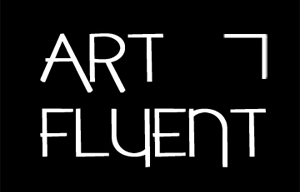
Notes for String Theory series, embroidery on canvas
-Candace, we'd love to hear your story and how you got to where you are today, both personally and as an artist.
I’ve been making books for over twenty years, and my interest in the book form stemmed from a love of reading fiction. My ongoing project Common Threads turned me into an accidental embroiderer, and I’ve been making use of that medium for a long time, too. Notes for String Theory, hand-embroidered pages, confront the existential possibilities of the blank page. The size, format, and color palette of notebook paper, they are familiar and warped at the same time. From across the room, they appear as flat, linear designs, but upon closer inspection reveal themselves to be delicately textured. Thinking about writer’s block, I began drawing versions of a blank sheet of paper in blue thread onto canvas. Where I had previously embroidered the text and illustrations of my artist’s books, I created a void. Not the first or last to confront the dread of the blank page or to bend writer’s block into subject matter, I have named my humble drawings for the theoretical framework uniting all matter and forces at play in the universe.

Notes for String Theory series, embroidery on canvas

Notes for String Theory series, embroidery on canvas

Notes for String Theory series, embroidery on canvas
-How has your artistic style and approach evolved over the years? Are there any pivotal moments or projects that marked a significant change in your work?
I did an exhibition at Women and Their Work, a non-profit in Austin in 2018 that was the most ambitious show I had ever attempted. To critically assess the morality of our obsession with murder mysteries I created dioramas and paper sculptures. Significantly for me, I didn’t sew any aspect of that show, and it helped me to put my ideas at the forefront rather than feeling limited by a technique.

Notes for String Theory series, embroidery on canvas
-What’s the best way for someone to check out your work and provide support?
I have exhibitions from time to time that people can attend or they can ask to see my books in library collections near them. I’m thrilled to work with an excellent gallery in Austin, Ivester Contemporary. Booklyn Gallery in New York specializes in promoting artist’s books, and they have represented me since 2008. I post new work on Instagram @candacehicksart, and I sell work via my website www.candacehicks.com
Statement
I once read two unrelated books in a row that both contained the phrase “black currant lozenge.” Unlikely synchronicities seem to happen to me often, and that’s true in part because I expect them. My work centers on being a reader of fiction. Literature informs every project, and artist’s books and writing complement imagery and objects. Text allows me to explore in depth the ways we construct meaning from mundane coincidences. Inspired by genre fiction, I critically assess the morality of our obsession with murder mysteries and investigate the ways that science fiction has a hold on our collective imagination to a greater extent than fact. To complicate the reader/viewer experience I encode text within interactive exhibits, populate dioramas with invisible ink clues, and create baffling optical illusions. Privileging craft traditions I employ embroidery, quilling, and paper constructions to illustrate interconnected stories. Regardless of medium I’m forever exploring our complex relationship with storytelling.

Notes for String Theory series, embroidery on canvas
Bio

Notes for String Theory series, embroidery on canvas
Candace Hicks collects coincidences from the books she reads in her artists’ books and installations. With the exhibition Read Me at Lawndale Art Center, Hicks opened the book form into a room-sized interactive installation in which viewers pieced together a puzzle of narrative to find the correct solution. The Locked Room at Living Arts in Tulsa focused on a specific genre of literature the “locked room” mystery, and visitors were tasked with the challenge to find the means of metaphorically escaping the gallery. For Many Mini Murder Scenes at Women and Their Work, Hicks reproduced tableaux plucked from crime fiction and offered viewers the experience of playing a detective searching for clues. Her work consists of artist’s books, video, performance, printmaking and drawing. Books from her Common Threads series are in more than 80 collections around the world including, MFAH, Metropolitan Museum of Art, Boston Athenaeum, Deutsche Nationalbibliothek, Grolier Club, Harvard, Hungarian Multicultural Center, MIT, MoMA, Museum of Applied Arts, Vienna, UCLA Biomedical Library, Stanford, and Yale.
